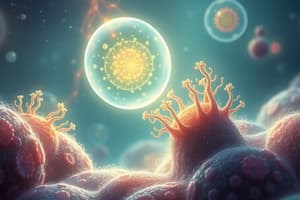Podcast
Questions and Answers
Which eukaryotic supergroup includes land plants?
Which eukaryotic supergroup includes land plants?
- Archaeplastida (correct)
- Excavata
- Unikonta
- SAR clade
Secondary endosymbiosis involves a heterotrophic eukaryote engulfing a photosynthetic prokaryote.
Secondary endosymbiosis involves a heterotrophic eukaryote engulfing a photosynthetic prokaryote.
False (B)
What specific structure produced by plants allows spores to resist harsh environments?
What specific structure produced by plants allows spores to resist harsh environments?
sporopollenin
The ______ are localized areas of cell division in plants that allow for sustained growth.
The ______ are localized areas of cell division in plants that allow for sustained growth.
Match the following characteristics to the plant group that possesses them:
Match the following characteristics to the plant group that possesses them:
What is the evolutionary significance of plants storing food energy as starch?
What is the evolutionary significance of plants storing food energy as starch?
Land plants evolved from red algae.
Land plants evolved from red algae.
What is the name of the structure that contains the egg in bryophytes?
What is the name of the structure that contains the egg in bryophytes?
The alteration between a multicellular haploid stage and a multicellular diploid stage is called ______
The alteration between a multicellular haploid stage and a multicellular diploid stage is called ______
Match the following groups to their descriptions:
Match the following groups to their descriptions:
Which of the following is a significant advantage for plants moving from aquatic environments to land?
Which of the following is a significant advantage for plants moving from aquatic environments to land?
Bryophytes have vascular tissue that allows them to grow tall.
Bryophytes have vascular tissue that allows them to grow tall.
Name one adaptation that allowed plants to thrive on land related to the need to conserve water.
Name one adaptation that allowed plants to thrive on land related to the need to conserve water.
The first vascular plants appeared approximately ______ years ago.
The first vascular plants appeared approximately ______ years ago.
Match the plant group with its example:
Match the plant group with its example:
During which geological period did vascular plants become dominant on land?
During which geological period did vascular plants become dominant on land?
Seedless vascular plants include gymnosperms and angiosperms.
Seedless vascular plants include gymnosperms and angiosperms.
What type of vascular tissue transports water and minerals?
What type of vascular tissue transports water and minerals?
[Blank] is a substance that provides rigidity to vascular plants, allowing them to grow taller.
[Blank] is a substance that provides rigidity to vascular plants, allowing them to grow taller.
Match the following structures with their function:
Match the following structures with their function:
What is the dominant generation in vascular plants?
What is the dominant generation in vascular plants?
Homosporous plants produce two types of spores.
Homosporous plants produce two types of spores.
What are the clusters of sporangia on fern leaves called?
What are the clusters of sporangia on fern leaves called?
Sphagnum, also known as ______, forms extensive deposits of partially decayed organic material.
Sphagnum, also known as ______, forms extensive deposits of partially decayed organic material.
Match the following groups to their dominant life cycle stage:
Match the following groups to their dominant life cycle stage:
The 'Tollund Man' provides evidence of what ecological role of mosses?
The 'Tollund Man' provides evidence of what ecological role of mosses?
Lycophytes, also known as club mosses, are true mosses.
Lycophytes, also known as club mosses, are true mosses.
What is the name for modified leaves that bear sporangia?
What is the name for modified leaves that bear sporangia?
The earliest plants in the aquatic environment were surrounded by nutrient solution and supported by ______.
The earliest plants in the aquatic environment were surrounded by nutrient solution and supported by ______.
Match the following plant groups with their key innovation enabling them to colonize land:
Match the following plant groups with their key innovation enabling them to colonize land:
Which algal group shares the most recent common ancestor with land plants?
Which algal group shares the most recent common ancestor with land plants?
Plants are thought to have initially moved to land to be closer to their source of water.
Plants are thought to have initially moved to land to be closer to their source of water.
What cellular feature do plants share with green algae that is relevant to storing energy?
What cellular feature do plants share with green algae that is relevant to storing energy?
The dominant generation in bryophytes such as mosses is the ______.
The dominant generation in bryophytes such as mosses is the ______.
Match the following terms with their definitions:
Match the following terms with their definitions:
Which of these is a challenge that plants faced when moving to land?
Which of these is a challenge that plants faced when moving to land?
Mosses, liverworts, and hornworts have true leaves and roots.
Mosses, liverworts, and hornworts have true leaves and roots.
What is the function of rhizoids in bryophytes?
What is the function of rhizoids in bryophytes?
Seedless vascular plants transport water and fluids, but they have a limited height as they do not contain ______.
Seedless vascular plants transport water and fluids, but they have a limited height as they do not contain ______.
Match the following plant groups with the geological period in which they appeared:
Match the following plant groups with the geological period in which they appeared:
Flashcards
Endosymbiosis
Endosymbiosis
The engulfing of one cell by another, leading to a symbiotic relationship.
Plastids
Plastids
Organelles used in photosynthesis, originating from endosymbiosis.
Archaeplastida
Archaeplastida
A eukaryotic supergroup that includes red algae, green algae, and land plants.
Green Algae
Green Algae
Signup and view all the flashcards
Plant
Plant
Signup and view all the flashcards
Alternation of Generations
Alternation of Generations
Signup and view all the flashcards
Sporopollenin
Sporopollenin
Signup and view all the flashcards
Gametangia
Gametangia
Signup and view all the flashcards
Meristem
Meristem
Signup and view all the flashcards
Move to land Advantages
Move to land Advantages
Signup and view all the flashcards
Move to land Disadvantages
Move to land Disadvantages
Signup and view all the flashcards
Land plants origin
Land plants origin
Signup and view all the flashcards
Bryophytes
Bryophytes
Signup and view all the flashcards
Pterophytes
Pterophytes
Signup and view all the flashcards
Rhizoid
Rhizoid
Signup and view all the flashcards
Archegonium
Archegonium
Signup and view all the flashcards
Sphagnum
Sphagnum
Signup and view all the flashcards
Vascular Plant traits
Vascular Plant traits
Signup and view all the flashcards
Sporophyte Dominance
Sporophyte Dominance
Signup and view all the flashcards
Sporophylls
Sporophylls
Signup and view all the flashcards
Homosporous
Homosporous
Signup and view all the flashcards
Heterosporous
Heterosporous
Signup and view all the flashcards
Study Notes
Eukaryote Phylogeny
- Anything in yellow is a "Protist"
Endosymbiotic Hypothesis
- Secondary endosymbiosis is a process where a eukaryote engulfs another eukaryote, leading to the formation of new organelles or cellular structures
Plastid Origin
- Plastids are organelles used in photosynthesis
- Red and green algae have double membranes
- Secondary endosymbiosis allows eukaryotes to engulf other eukaryotes
- Archaeplastids share a common ancestor
Algae Evolutionary Relationships
- Green algae gave rise to charophyceans
Shared Traits of Plants and Green Algae
- Plants share characteristics with green algae
- Both are photosynthetic with chlorophyll a and b, and carotenoids
- Both are multicellular and eukaryotic
- Both have cellulose cell walls
- Food energy is stored as starch in both
- They share biochemical similarities
Defining the Plant Kingdom
- Key traits separate land plants from charophytes
Four Key Plant Characteristics
- Alternation of generations occurs
Spores & Sporangia in Plants
- Spores are adapted for harsh environments
- Sporopollenin assists with adaption
Gametangia & Meristems
- Plants have multicellular gametangia
- Archegonium and antheridium are their components
- Meristems are localized areas of cell division
Mosses
- Mosses are dominantly gametophyte tissue
- Gametophyte tissue is haploid and makes gametes
Plants Moving to Land
- Plants moved to land for unfiltered sunlight and more carbon dioxide
- Land offered more nutrients in the soil and initially fewer herbivores and pathogens
Early Plant Environment
- Early plants existed in aquatic environments, surrounded by nutrient solutions and supported by water
Transition to Land Challenges
- Transitioning to land presented challenges like desiccation, nutrient access, reproduction, and support
Land Plant Evolution Timeline
- Land plants originated approximately 475 million years ago
- Vascular plants emerged around 425 million years ago
- Extant seed plants appeared about 305 million years ago
Main Plant Groups
- Bryophytes include mosses, liverworts, and hornworts are from earliest terrestrial ancestors
- Pterophytes possess vascular tissue, roots, cuticle, and stomata
- Gymnosperms produce pollen grains and naked seeds (cones)
- Angiosperms produce flowers and fruit (enclosed seeds)
Non-Vascular Plants
- Phylum Hepatophyta consists of Liverworts
- Phylum Anthocerophyta includes Hornworts
- Phylum Bryophyta is made up of Mosses
Liverwort Classification
- Marchantia polymorpha is classified as a thalloid liverwort
Bryophyte Characteristics
- Bryophytes lack true roots, having rhizoids instead
- They lack a complex transport system for water and fluids
- Growth is limited by size without lignin for support
- Water is needed for reproduction
- Some hornworts and moss sporophytes have stomata
Bryophyte Reproduction
- Bryophytes use flagellated sperm
- The gametophyte generation is dominant
- Both male and female gametophytes are present
- Flagellated sperm is produced in the antheridium
- Eggs are produced in the archegonium
- The fertilized egg is retained in the archegonium and becomes an embryophyte
- Sporophyte generation makes spores
Moss Tissues
- Gametophytes are generated when a plant evolves vascular tissue
Moss Ecological and Economic Significance
- Sphagnum, or "peat moss," forms peat deposits from decayed organic material
- Mosses play a role in Earth's carbon cycle by storing large amounts of carbon
- They are harvested for fuel and soil conditioning
- Temps and oxygen levels lower the PH which slows decay of mosses
Seedless Vascular Plants
- Phylum Lycophyta contains club mosses
- Pterophyta consists of ferns and horsetails
- The first vascular plant appeared approximately 420 million years ago
- Dominance of vascular plants on land occurred in the Carboniferous period, around 360 million years ago
Vascular Plants
- Vascular plants possess dominant sporophyte generations
- Xylem and pholem are used within vascular systems
- Lignin for support
- Roots absorb nutrients and anchor
- Leaves serve as sites for photosynthesis
- Sporophylls are altered leaves with sporangia
Early Forests
- Early forests were dominated by seedless vascular plants, which grew to great heights
- This occurred during the Devonian and early Carboniferous periods
- Decreasing carbon dioxide levels may have contributed to significant global cooling near the end of the Carboniferous period
- Decayed plant material in forests eventually became coal
Studying That Suits You
Use AI to generate personalized quizzes and flashcards to suit your learning preferences.




